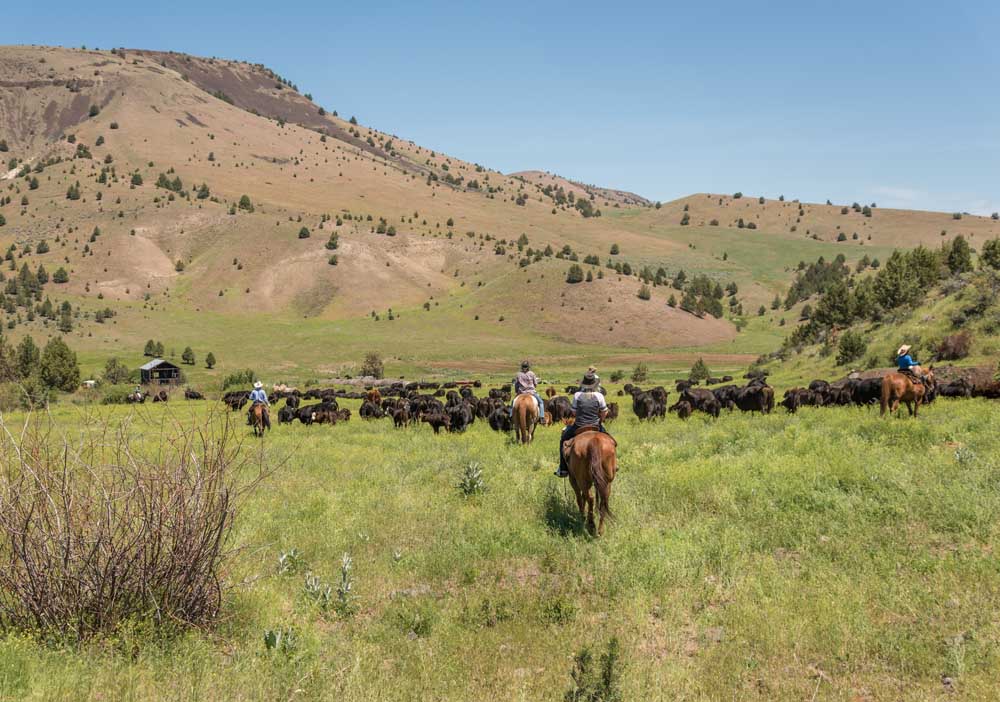Buying the Ranch
Published 12:00 am Saturday, March 5, 2016

- Buying the Ranch
As the cattle tromp toward the nearby fence line from across the pasture — a wide open space that seems to stretch for miles into the hills beyond — the kids holding handfuls of hay chuckle in excited anticipation. They stand close to their grandpa, knowing he will keep them safe when the cows get close. There’s a twinkle in his eyes and a satisfied grin stretches across his face. For Tim Carter, being able to share a little piece of the ranching life with his grandchildren is priceless.
Knowing his grandkids’ generation is growing up in a new world, where technology seems to touch every aspect of their lives, makes it all the more important to Carter that they remain connected to the land and to their roots.
When Carter and his partner, Linda Cook, bought the acreage on the edge of Prineville it was just to have a wide open space to call their own. In the beginning, they leased the irrigated pastures to acquaintances, hosting cattle for ranchers who needed additional grazing land for their herds. But over time, the allure of the ranching life drew Carter and Cook in, prompting them to purchase their own small herd.
While raising cattle has become a part of their lives, like many others, the couple has maintained their other business to support their livelihood. Tim Carter Concrete still dominates most of the work day, but having the ranch is like owning a little part of the original American dream.
“We do not have a lot of farms and ranches in Central Oregon that support themselves, most are supplemented from outside jobs,” noted Pam Mayo Phillips, Realtor with Cascade Sothebys International Realty. The cost of farming, she explained, can be quite high when you take into account irrigation costs, labor, taxes and variable markets.
Despite the challenges associated with making a living off the land, Mayo Phillips said ranching and farming have had a resurgence in popularity in recent years. This is especially true, she added, in Central Oregon, a place many equate with the land of the original old west and a simpler lifestyle.
Today’s trend toward reconnecting with the land and toward teaching the younger generations to understand where food comes from drives many families to seek their own open spaces to grow and nurture livestock and crops.
“It’s refreshing to see our young people interested in farming again,” Mayo Phillips said. With a strong ranching and farming background herself, Mayo Phillips has a particular appreciation of this growing trend. “A few years ago young people were not going back into the family farms.”
Today, multi-generational farmers and ranchers who have called Central Oregon home for more than a century co-exist with a growing group of new farmers and ranchers.
“There are small organic farm operations coming into the area and they are doing well in the niche markets when they have good local buyers,” Mayo Phillips noted.
Unlike the much larger farms and ranches that raise hundreds of head of cattle or grow acres upon acres of produce, the small farms offer their owners an opportunity to be a part of the growing locavore movement without having to have an extensive background in farming and without having to invest in quite as much property.
Large or small, Central Oregon ranchers and farmers face unique challenges.
“Farmers who choose to live and work in Central Oregon are especially rugged because they must address and overcome soil and elevation challenges, the fear of frost nearly year-round, and the seasonality of our irrigation services, among other things,” explained Katrina Van Dis, a founding and current board member of the High Desert Food & Farm Alliance.
But the challenges are not road blocks. The success of numerous local start-up farms illustrates that despite the sometimes less than ideal soil conditions, and in spite of the high desert climate with its extreme temperature range, it is possible to have a little piece of the American dream and to do something positive with it.
In today’s real estate market, even as demand often exceeds available properties, buyers are educated and will work tirelessly with their Realtor to find the right piece of land for the right price.
Beyond the usual considerations when buying a home, buying a farm or ranch involves a number of other factors.
“The price of the property is going to depend on the quality of the water rights and how the property is irrigated — what type of irrigation system is used and condition of the system,” Mayo Phillips explained. “Price will also depend on the size of the farm or ranch, location, soil types, as well as the condition of the home and any outbuildings.”
Ultimately, it is about supply and demand and the probability of success.
Water plays a huge role in the success of any farm, and as Mayo Phillips explained, future water rights in Central Oregon are causing concerns with area farmers and ranchers.
The Oregon spotted frog was listed as threatened by the U.S. Fish and Wildlife Service in 2014. That classification lead the Center for Biological Diversity and WaterWatch of Oregon to file for a preliminary injunction in early February this year, requesting the Bureau of Reclamation and three irrigation districts in Central Oregon to manage the river’s water differently.
The outcome of the spotted frog issue and how it affects Central Oregon irrigation districts will have a direct impact on local farmers, ranchers and recreation users, Mayo-Phillips explained.
But frogs or no frogs, the draw to honor our roots is strong. The desire to reconnect with the land and to our food is real. There are many people who long for wide open spaces in place of tiny backyards.
“There are buyers who want to produce their own food, by gardening and raising livestock – pigs, chickens and cows,” Mayo Phillips said. “They want to teach their children responsibility and to be productive. The key to farming is going to be educating our young people on where our food comes from.”
It may not always be an easy lesson to learn.
As the cows chew appreciatively on the hay just inside the fence at Carter’s accidental ranch in Prineville, his grandchildren chatter about how big they are and laugh at the way they eat. A calf among the cows makes his way through the herd.
“Here comes little Hamburger,” Carter remarked.
All at once the kids look up at him.
“Don’t call him that,” one of them admonished. “We are NOT going to eat him.”








